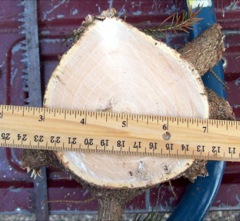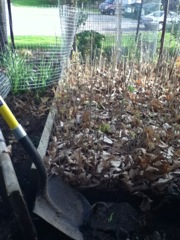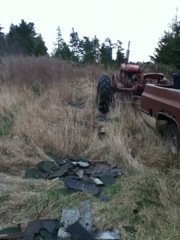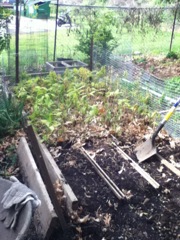2012:
Abstract:
The Summer of 2011 was warm and wet. It was one of the best growing seasons we have had since we first began planting these trees. Growth rings on White Spruce showed almost 1/2 inch growth in diameter over the past four seasons (NOTE: multiply this by aprox. 80,000 to estimate total biomass production for this tree farm).
Over the past winter we have continued to prune up these evergreens and thin where they are already too crowded. We are knocking down any white pine that have been infected (totally) with blister rust and removing infected branches where the main tree still looks like it might recover (lesions and symptoms haven't reached the main trunk).
2012 I plan to spend a lot more time at the farm and in longer stretches. This will allow me to apply a more consistent effort to some troubling management areas and hopefully this added attention (quantity and quality) will pay dividends.
The primary areas of concern are:
- Area to the west of the homestead ("West 40") where trees have been planted multiple times but can't seem to compete with the grasses to get a start.
- Clear invading brush and undesirable trees from the woods to the west. Re-establish fire buffer between our woods and the neighbors.
- Continue removal of invasive trees and brush like box elder and buckthorn.
- Continue clearing underbrush from 'old windbreak' and promoting desired species - either planted naturally or by us. Knocking down areas where growth is thick and tall. Spot spray roundup on areas that have been previously knocked down to prevent re-growth. Much of this break had blown down and now the trees are rotting to a point where they don't prevent the use of a tractor with bucket and brush hog.
- Watch Eagle pair as they raise their young.
- Continue de-constructing old barn.
Planting Trees.
March 2012 we began transplanting White Oak and Red Oak seedlings in the area west of the homestead. This is the 3d planting of much of this area (heavy sod and weeds have so far defeated our attempts at release). This year we will try using some heavy mulch to control weeds around the new seedlings.
The seedlings were raised from seed in my back yard in Madison. They were planted in the fall of 2009 in a screen covered raised bed that was filled with compost to make digging easier when it came time to transplant. I wanted to transplant these last spring but time didn't cooperate. The second summer of growth in that tight bed caused a lot of the plants to be crowded out. I probably lost half my trees but I still had 650 which is plenty for me to plant.
I dug 200 and brought them along on a short trip in March. This year March was so warm (record month) that they had already begun to break bud when I dug them.
David, my nephew, and I dug them in the sod and mulched them with some of the rotting wood and shingles from the de-construction of the old barn. The soil had nice moisture so this went fairly fast.
In this area of the farm the sod is so thick and the grass grows so fast that everything I have tried to release the transplants has had VERY limited success. I have tried pre-emerge, post-emerge and broad spectrum herbicides. I have tried mowing. I have tried plowing a furrow before planting. I have tried old carpet pieces.
I have even tried tree-tubes (very expensive).
This time I am trying surrounding the new plants with old shingles and rotted boards from the old barn. This may not look very nice but it should help do the three things I haven't had much luck with so far:
- Hold down the grass.
- Mark the tree so it doesn't get mowed down, run over, or plowed up when I'm trying to plant a replacement.
- Control deer browse and rubbing by making it 'not so easy' for them to get close to the tree.
Nursery in May 2012
Transplant pulling: 500 remaining Red Oak and White Oak seedlings from personal nursery.
The word 'pulling' is quite wrong. These seedlings are carefully dug from a well composted bed with care not to cut too much of the tap root or strip off too many of the fine root hairs in the process.
The summer of 2012 was pretty much taken up with the removal of the old barn and salvage of the beams and barn wood. [See Barn web site] This barn project took nearly all my time but I still had some spare moments to spend in the woods. Those were spent attacking weed trees like box elder and buckthorn with saw, roundup, and stump herbicide - both basal bark application and slash and spray with and Garlon in oil and Tordon RTU respectively.
I also had some time to swing my saw a bit and prune up the pine in the area along the field road that leads back to the back-40. This area has had very good survival numbers and growth over the past few years has closed the canopy in many places. I am pruning white pine to mitigate blister rust. I have started pruning red pine as well in order to improve the tree quality for saw logs (vs pulpwood). This opens up the whole stand so I can actually see what's going on and what needs to be done in the future. Many - I'd say most - areas in this planting have very good stands of hardwood as well. These trees are extremely crowded and in many cases need a little help getting to the sun (keeping up with the pine).




